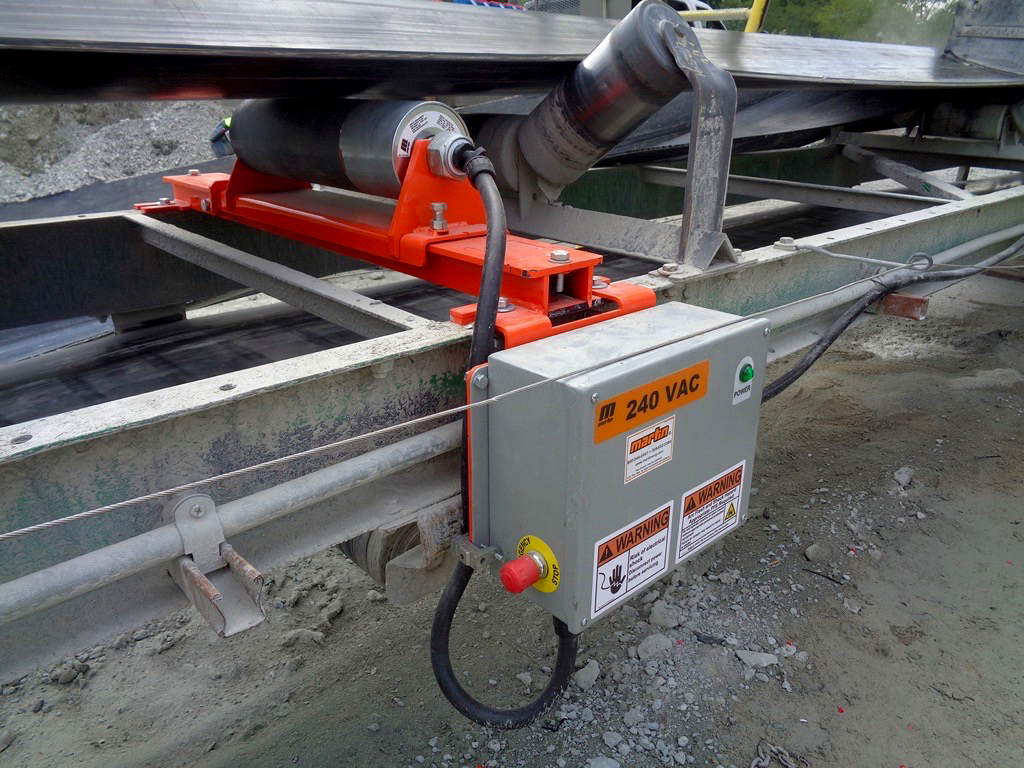
The Martin® Roll Gen System is designed to create a self-contained mini power station that allows operators to run electrical monitoring systems, safety devices and a variety of other components. Able to be retrofitted on existing idler support structures, the generator can be employed on virtually any steel roller. The device is considered a significant step toward eliminating power production obstacles, as conveyors move into the next generation of “smart systems” that are predicted to be more sustainable and autonomous.“Running auxiliary power can be both complicated and costly, requiring expensive labor and oversized cables to accommodate the inevitable voltage drop over long runs, as well as transformers, conduit, junction boxes and other components,” commented Andrew Timmerman, Product Development Engineer at Martin Engineering. “And using even a small conventional generator to provide power introduces a different set of issues, including flammable fuels.”
The Long Ride

Conveyor #107-1 is the longest outdoor conveyor system on the Illinois Cement site, running 600 feet (182 m) and discharging either onto the #107-2 stack-out conveyor or the 250-foot-long (75 m) belt leading directly into the plant, based upon immediate production needs. It’s a 30-inch wide (762 mm) mechanically-spliced belt with a 35º trough that travels at ~400 fpm (2 m/s), conveying nearly 300 st/h (272 mt/h) of limestone. Material arriving from the quarry can be either wet, dry and dusty or anything in between, depending on the season and weather. The changing work environment presented challenges throughout the entire conveying system, with different weather conditions triggering various types of carryback. Cleanup was labor-intensive.“The primary cleaner blades we had in place wore quickly, causing spillage that required us to take personnel from other areas to clean the buildup,” explained Illinois Cement Maintenance Planner Brian Brandner. “We were out there cleaning or adjusting the tension to minimize spillage a few times a week. When it got really cold, we wouldn’t have as many issues with dust or carryback, but the frost accumulation required us to keep the belt running at all times, which lowered the blade life and caused undue wear on the belt.”Phase one of the Martin Engineering solution involved placing a “smart” dust suppression system at the transfer point between the 153 and 107-1 conveyors. Phase two included an automated, pneumatically-tensioned belt cleaner and air cannon system at 107-1’s discharge zone. Both components are powered by the Roll Gen System.

To manage the dust, technicians installed a Martin® Surfactant Dust System at the transfer point between 153 and 170-1 to deliver a chemically-enhanced water spray as a topical treatment for material at the point of emission. Triggered by a sensor as soon as the load enters the transfer point, the system supports dust mitigation measures already in place to minimize the labor needed for maintenance and replacement of the dust collector cartridges. Cleaning the BeltClose to the mid-point of the system, conveyor 107-1 begins a gradual 20-foot (6 m) rise and discharges into the transfer chute leading either to the stack-out conveyor feeding the storage area or the main conveyor entering the plant. At that transfer point, technicians installed a Martin® QC1 Primary Cleaner XHD (extra heavy duty) tensioned with an Automated Blade System (ABS).

Connected to a small 24V DC air compressor and a control panel powered by the Roll Gen, the ABS pneumatic tensioner delivers precise monitoring and tensioning to reduce the labor typically required to maintain optimum blade pressure through manual adjustment. Equipped with sensors to confirm when the belt is running empty, the system automatically backs the blade away, minimizing unnecessary wear to both the belt and cleaner.

Upon detection of an empty belt, the system is set to run for one full belt rotation to clean the surface thoroughly before pulling away. The result is consistently correct blade tension with reduced power demand on start-up, all managed without operator intervention.“The new cleaner has been a game changer when it comes to the amount of maintenance, equipment wear and manpower for cleanup,” Brandner pointed out. “The blade is no longer just scraping an empty belt, which has extended its operational life and minimized wear to the belt face and splice.”
Transfer Chute Flow

While monitoring the results of the installation, Martin Engineering technicians observed that the decreased spillage resulted in a proportional increase in fines discharged down the transfer chute. Exposed to the outside environment, the chute began to form significant buildup along the sides, at the diverter gate and on the internal shelf meant to slow the flow of material. The technicians had a solution to this unexpected result, and to mitigate the buildup, they installed a Martin® Hurricane Air Cannon. “When there’s cargo flowing, the cannon fires about every ten minutes, which keeps fines from clinging to the walls and promotes proper flow,” Brandner said. “If the material is extra wet and building up faster than usual, we can just go over and fire it manually at any time.”
Results
The use of multiple technologies working in tandem to control material flow and prevent fugitive particles has dramatically improved the material handling system’s efficiency. The modifications have helped Illinois Cement reduce labor and equipment expenses, considerably cutting the manpower needed to clean spillage along the conveyor path. The result is a cleaner, safer and more productive operation. “The entire project has been a success, particularly in how many man-hours we save in maintenance and upkeep,” Brandner concluded. “The tensioning system does a great job, and the Roll Gen puts out enough power that we’re considering adding an automated secondary cleaner and a vibrating dribble chute to capture even more carryback.
■







